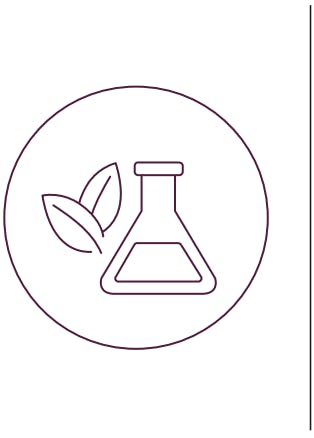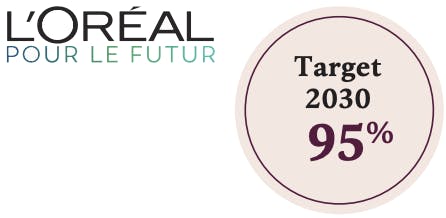Therefore, with regards to raw materials, the Group promotes green chemistry principles which encourage the development of ingredients with a favourable environmental profile made from plant raw materials, which minimise the number of synthesis stages, the consumption of non-toxic solvents and energy, and the production of by-products.
In 2021, the percentage in volume of the raw materials used by L’Oréal coming from green chemistry(1) was 28%. This represents more than 717(2) raw materials. In 2020 (recalculated using the new methodology), this percentage was 28%.
In 2021, 63% of the newly referenced raw materials are renewable. Furthermore, 33 new raw materials based on green chemistry principles were registered, representing 40% of the total.
The Group considers biodiversity to be a key source of innovation. Accordingly, plans to increase the use of raw materials from plant sources must ensure that there is no impact on these ecosystems or on the availability of these resources for other uses. The Group is thus making a commitment to a sustainable and responsible supply chain (see paragraph “Using the Group’s purchasing power to serve social inclusion” in section 4.3.1.2.2. of this document).

In 2021, 60% of our ingredients in formulas were from biobased sources, derived from abundant minerals or from circular processes.

By 2030, L’Oréal is committed to ensuring that 95% of the ingredients in its formulas will be from biobased sources, derived from abundant minerals or from circular processes.
As part of this commitment, the Group is working with specialised external partners to define a robust, scientific methodology to classify the minerals used and to ensure that they are from abundant sources.
Respect for biodiversity and societal contribution
In 2018, as part of the Act4nature initiative, L’Oréal set a goal of having 100% renewable raw materials coming from sustainable sources by 2030. To be included in this category, they must be traceable, with an identified botanic and geographic origin. The respect for Human Rights in accordance with ILO principles is now expected throughout the production chain. At the level of plant growing and harvesting, attention is also placed on the economic development of the producers and respect for the traditional knowledge coming from biodiversity in accordance with the principles of the Nagoya Protocol (preservation of biodiversity, and fair and equitable sharing of the benefits with local communities).
In 2021, 100% of the renewable raw materials used by the Group were reassessed based on criteria such as respect for biodiversity and forced labour (see SCAN Index below).
Furthermore, the traceability campaigns launched with all the Group’s suppliers have made it possible to trace 100% of plant-based ingredients to their country of production, or even as far as the biomass production site. In 2021, the portfolio of raw materials from renewable sources therefore comprised 1,717(3) raw materials from nearly 313 botanical species from more than 100 countries.
Out of the 313 botanical species that are the source of the renewable raw materials used by the Group, around 6%(4) present significant biodiversity challenges (endangered species, and impact of production on natural environments) depending on their geographic origin and the method of extraction or production used. They are the subject of specific action plans initiated with suppliers and, if necessary, benefit from the systematic support of independent external third parties, in order to manage the real impacts on the territories of origin of the ingredients.
-
- For the palm oil and its by-products segment, which are the subject of a specific “Zero deforestation” approach (see below), at year-end 2021, 100% of the supplies were covered by action plans with the suppliers concerned.
- For other streams of renewable raw materials, which represent 17% of the portfolio of renewable raw materials in volumes and 74% in number, L’Oréal, on the basis of environmental, social and economic indicators from external databases (IHDI of the UNDP, EPI from Yale University, Verisk Maplecroft Country Index), has defined indicators of “sustainable sourcing challenges” to assess renewable raw material streams with regard to their sustainability. These indicators are consolidated within the SCAN (Sustainable Characterisation) index, allowing the Group to prioritise the implementation of its sustainable sourcing action plans. The Group updates the information collected regularly. 79% of the volumes of raw materials that have sustainable sourcing challenges according to the SCAN Index (i.e. 36% in number of raw materials) are already the subject of improvement action plans with the suppliers in question in order to ensure a sustainable supply. The goal is for 100% of the Group’s renewable raw materials to come from sustainable sources. To achieve this, L’Oréal launched a support and training programme for more than 200 suppliers on the issues of sustainable sourcing of raw materials in order to guarantee the traceability of the raw materials delivered to L’Oréal and ensure the associated streams are secure. Depending on the level of environmental and/or social risk identified on these streams, suppliers are notably asked to deploy the field audit procedure for producers (88 indicators), developed by L’Oréal with the support of the Rainforest Alliance NGO and reviewed in 2019 by EcoCert, The Biodiversity Consultancy and The Danish Institute for Human Rights. They are also invited to rely on sustainable sourcing certifications adapted to the challenges of their streams (Fair Trade, Sustainable Agricultural Network, Organic, etc.).
(1) This means derived from renewable resources, transformed by an eco-friendly process and offering a favourable environmental profile.
(2) Determined according to production.
(3)Calculated on the basis of projected purchases between January and November 2021
(4)Calculated on the basis of projected purchases between January and November 2021.
